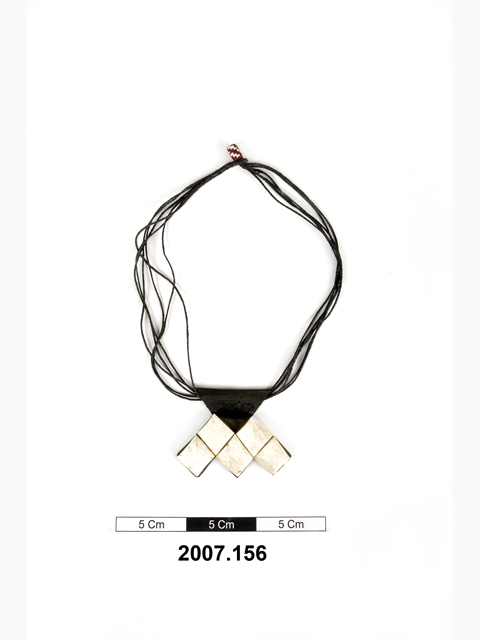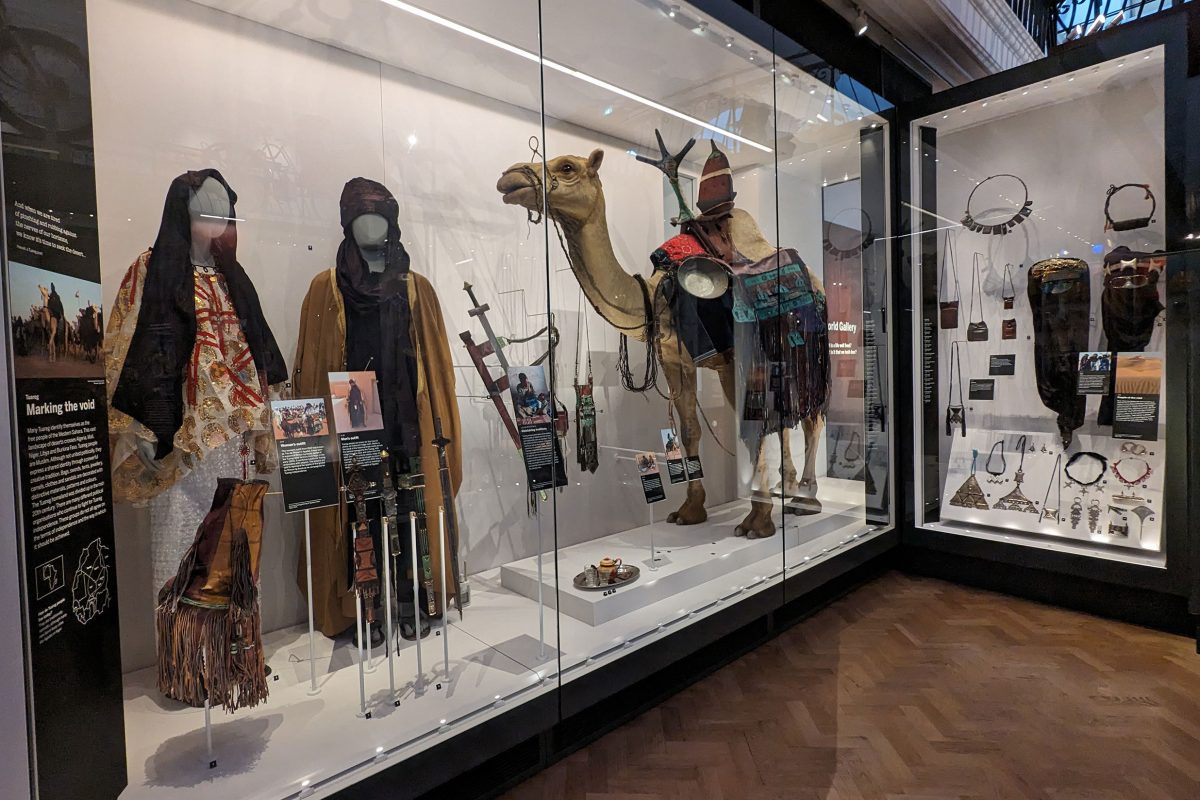To me, a trip to the Horniman is an occasion to make a fresh pair of clothes for my mind, or at least try on a new outfit. It’s a chance to see things differently from another human perspective.
Sometimes I just go and see how things strike me, but to get the most out of a trip I put a bit more work into it.
I’m a jeweler, making fine jewellery using precious metals and stones. I gain a lot from looking at how jewellery has been made in other cultural contexts, and trying to build a bridge from my own to the knowledge of others.
In this case, I explored a Tuareg necklace in the Horniman collection.

necklace (neck ornament (personal adornment)); protective charm
Anthropology
One of the descriptions for this object is:
A necklace, with a pendant of five diamond/rhombus shaped eggshells mounted on layered blackened leather. Their arrangement forms a rough trapeze. At the top there is a leather strap, through which the tawlulut (leather, multi-stringed necklace) is threaded. This type of khomeyssa made with bone or shell is more common in Mali, whereas silver ones are more widespread among the Kel Ahaggar (Algeria) and the Kel Ifoghas (south-western Niger). The khomeyssa refers to the arrangement of the ‘rough trapeze’, reflecting a stylised version of the hand of Fatima known as Khamsa.
The Tuareg are traditionally a nomadic people who inhabit the Saharan regions of North and West Africa. Today, most Tuareg live in the northern areas of Niger and Mali, the southern area of Algeria, Libya and parts of Burkina Faso.
The first things I noticed about the necklace were the materials – leather, shell or bone. These speak to a material culture where these resources are more readily available. But why not gold, I thought, as I am used to? I learned that gold is considered a negative metal within Tuareg culture because it is so highly valued. It excites human greed and can lead to violence. so, silver is used for making jewellery.

The Tuareg necklace that inspired Kassandra (marked 10)
Using bone and silver because they are less valuable materials is a fascinating cultural adaptation, because many wouldn’t assume people would prefer less valuable ‘assets’. I wondered whether, being nomadic and away from institutions like the police to offer protection, this was adopted to decrease the incentive to be attacked and robbed. My mind wanders to the money transport vans that drive around London and very explicitly state that no cash is stored in the vans overnight.
I start to paint a picture of the meaning of jewellery in Tuareg society, and it raises questions. Tuareg women wear a lot of jewellery: pendants, earrings, finger rings and bracelets. Are Tuareg women seeking safer lives by sticking to non-‘negative’ materials?
I also started to wonder what functions jewellery play in Tuareg society. For us, some jewellery can signal identity (being married or engaged), it can denote wealth and status, it can be decorative and more. It can also be a store of value. In Tuareg society, the function of jewellery seems to overlap with many of these meanings. It can signal status, belonging to a tribe (in a way that seems more similar to a coat of arms), or wealth, but does not appear to necessarily be a store of value.
One way it differs, is Tuareg jewellery is often used as an amulet. It is believed to have qualities that ward off harm. In the case of this necklace, the five diamond shapes may only represent the five pillars of Islam.
Although lots of items of jewellery are worn as charms for luck and protection, these are generally on display. However, a lot of Tuareg jewellery serves to deter jinns (from which we get ‘genies’) – who live in the immaterial world – from interfering with the wearer, in ways that can cause madness or disease. As such, some jewellery is not even worn visibly.
This speaks to me of a world where people believe that although many things are ultimately out of their control, there are still some precautions they can take to improve their fates.

Hanna Sotkiewicz mentions in her academic article, Amulets and talismans of the Central Sahara – Tuareg art in context of magical and mystical beliefs:
The Tuareg’s belief in talismans and amulets is based on the view that there exists a general balance between the material sphere (which means all things surrounding all creatures, such as nature and universe), and the immaterial sphere (which means the world of spirits in the magical and mystical sense). Thus the balance between the world of human beings and the ghosts and Jinns of the desert is formed.
This may feel pre-scientific but there are many parallels with our society. Many people wear crosses and St. Christopher medallions to ward off harm, for example, and horoscopes can be found in national publications. You can see pictures of some of the jewellery charms that people wear in the World Gallery.

The charms that some people wear or carry today, World Gallery
As a jeweller myself, I’ve designed a necklace that draws aesthetically and symbolically from braids, a common afro hairstyle. The idea is that by weaving together the strands of experience – even traumatic experience – as well as effort and striving in the Black experience, we can knit them into something stronger. A braid can become like a rope that can support us; that we can climb upwards, that we can use to lift someone else. In some way, this is nothing but a helpful belief, as attractive and beautiful as it is to me. But if I’m comforted or encouraged by this belief as I wear my necklace, how far is it from an amulet itself?
These were some of the thoughts I had when exploring this beautiful necklace.
Another thing struck me as important later on. I had a conversation with former Horniman Museum anthropologist and curator, Ursel Widemann, who collected the necklace. I asked her questions about the origins of the necklace. She said that the seller told her that it could be 10-12 years old when it was bought.
I wanted to find out the significance of the necklace. I pressed her to find out what the meaning behind the necklace was, trying to figure out why a woman would wear this necklace in this region. Ursel mentioned that the necklace is a simple everyday decorative piece of jewellery, typically worn by Tuareg women in rural areas. I asked her about the significance of the diamond symbols, and Ursel confirmed that the symbol of five diamond shells has great significance. The number five is a lucky number in the culture and relates to the five pillars of Islam.
I was grateful for the opportunity to expand my horizons through this necklace. It adds a new strand into my understanding of what jewellery can be, and gives me a new way of interrogating my own jewellery-making, which helps me creatively. By the end of this investigation, I certainly thought I got more out of my encounter for putting more effort into it.
What are your interests, and what object might be waiting to tell you something new and exciting about it?


